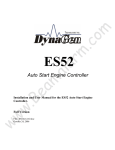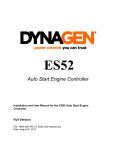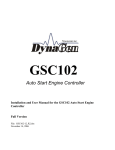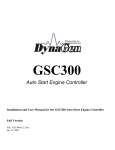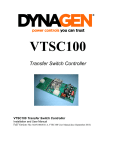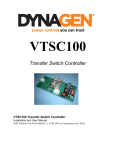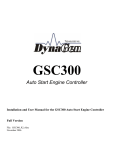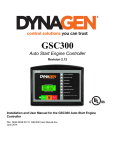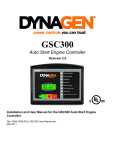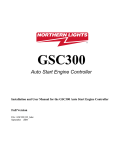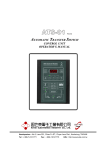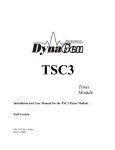Download ES53 User Manual R1.31
Transcript
ES53 CONTROL MODULE Installation and User Manual for the ES53 Control Module File: ES53rev1.31.doc March 1, 2005 2 Thank You For Purchasing This DynaGen Product Please Read Manual Before Installing Unit Receipt of Shipment and Warranty Return Information Upon receipt of shipment, carefully remove the unit from the shipping container and thoroughly examine the unit for shipping damage. In case of damage, immediately contact the carrier and request that an inspection report be filed prior to contacting DynaGen. All returned items are to be shipped prepaid and include a Return Material Authorization (RMA) number issued by DynaGen. RMA forms are available by contacting DynaGen Technical Support through the contact methods listed below. Limited Warranty DynaGen will repair or replace any ES53 controller which proves to be defective under normal and proper use within Three Years from the date of shipment. This constitutes the only warranty and no other warranty shall be implied. We welcome your comments and suggestions. Please contact us at: DynaGen Technologies Inc. Phone: 1-888-396-2436 (902) 562 0133 Fax: (902) 567 0633 Email: [email protected] WEB SITE: www.dynagen.ca Installation and User Manual for the ES53 Control Module 3 Table of Contents INTRODUCTION 4 SPECIFICATIONS 5 WIRING INSTALLATION GUIDELINES Wiring instructions, types and sizes Wiring guidelines Terminal description General Wiring Diagram Outline Dimension Drawing 6 6 7 8 10 11 CONTROL MODULE OVERVIEW 12 ADJUSTMENTS AND SETUP PROCEDURES Crank Disconnect calibration Over-speed calibration Crank/Rest time calibration 13 13 14 14 DIP SWITCH CONFIGURATION 14 LOGIC SEQUENCE 16 LED INDICATIONS 17 TROUBLESHOOTING GUIDELINES 18 Installation and User Manual for the ES53 Control Module 4 INTRODUCTION The ES53 Control Module is a combined “engine controller + time delay module.” It is typically mounted at the engine, to minimize runs of heavy current carrying wiring. With #22 gauge wire, the distance between engine and transfer switch can be up to 400 feet. Standard cable length supplied with the package is 50’, and other lengths are available in 25’ increments. The cable has the connector terminals pre-mounted on one end, but the engine end must be field installed. Please refer to the AST3225 Manual for system wiring diagrams with the control module and transfer switch. • Differential speed sensing inputs (for twisted-pair connection): Very effective interference prevention by means of noise cancellation. • Excellent EMI handling: Software detection of, and recovery from, noise corruption. • REPLACEABLE RELAYS; Replaceable relays provided within on board sockets. Relays Rated 20 Amps at 30 VDC • REPLACEABLE FUSE; On board replaceable 20A fuse, mini-fuse (standard automotive type). • Reversed supply protection; No requirement for series diode on supply. • 3.3V to 30V, -40ºc. to +85ºc. operation: Works anywhere, anytime . • Zero Speed Restart: Prevents starter pinion wear by ensuring that no engagement of the starter is possible unless the speed is zero. • Oil Bypass Failure: Waits 15 seconds from start for 1-3 crank tries, and 20 seconds for more than 3 crank tries, before enabling Low Oil pressure monitoring. Requires no user setting. • SMALL SIZE; 3.302” x 3.342” x 1.842” 0.67lbs Installation and User Manual for the ES53 Control Module 5 SPECIFICATIONS Operating VDC limits: (3.3VDC min.- 30VDC max.) Standby current draw: 12mA at 12VDC (12mA at 24VDC) Operating current draw: 140mA at 12VDC (80mA at 24VDC) Reverse polarity protected: Internal protection will prevent damage to unit under a reverse polarity condition. Re-connect power leads properly, and normal operation will resume. Speed sensing input accepts: Generator AC output directly Speed sensing maximum rating: Withstands Line voltage (300 V.A.C.) Operating temperature range: -40 O C ⇒ +85 O C Operating humidity range: 0 ⇒ 95% non-condensing Fuel & Crank contact output: 10 Amps max. each Continuous Sourcing (+bat) output Annunciation outputs: Sourcing (+bat) outputs (300ma max. per output) Lamp Test terminal: Close to + Battery to test LED’s Actual unit weight: 0.67 lb. (0.30kg) Shipping weight: 1 lb. (0.45kg) Unit dimensions: 3.302” x 3.342” x 1.8” Shipping dimensions: 4” (10.16cm) x 4” (10.16cm) x 3” (7.62cm) Installation and User Manual for the ES53 Control Module 6 WIRING INSTALLATION GUIDELINES Danger: Never work on the engine while its power is on. This controller does not generate a warning signal prior to automatic engine start. Warning signs should be placed on engine equipment indicating this important safety measure. INSTRUCTIONS Following these instructions will help avoid common installation problems during wiring and setup. • Battery must be disconnected before any wiring connections are made. • Wire length from the engine to the controller should not exceed 6 meters (20 feet). Wiring size and type should be as specified below. Use stranded wire, since solid wire has a tendency to crack, break and loosen over time. TYPES AND SIZES Terminal Wire Size Current max. Function CON 1 Harness supplied 18 18 18 18 14 12 12 12 12 12 14 18 18 18 18 18 100mA Speed signal connection via on board connector LED test switch Oil pressure switch High Temperature switch Auxiliary Input switch Starter solenoid/pilot relay Battery negative (-) Auto switch RSC1 (remote start contact connection) RSC2 (remote start contact connection) Start/Stop connection Fuel solenoid/pilot relay Timer output Annunciation outputs Normal Disable Emergency Disable Ground connection 1 2 3 4 5 6 7 8 9 10 11 12 13 ⇒ 17 18 19 20 100mA 7mA 7mA 7mA 10 A 20 A 20 A 20 A 20 A 20 A 10 A 300mA 300mA 300mA 300mA 300mA Installation and User Manual for the ES53 Control Module 7 WIRING GUIDELINES 1. DO NOT use wire smaller than 18 AWG. 2. The connections supplying DC power to the ES53 panel should preferably run directly from the battery posts with no splices or other connections except a 25A fuse connecting the positive line directly to the +Battery terminal. Avoid, as much as possible, using chassis (aluminum or iron engine parts) as return conductor for battery negative voltage; copper wiring is recommended. Failure to follow the above may result in erratic operation, due to large voltage drops across wiring connections. 3. DO NOT short Crank output or Fuel outputs to ground, as this will cause on board 20Amp fuse to blow and may result in damage to ES53 on board relays. 4. When replacing fuse, removable terminals and relays, only use factory recommended parts. 5. DO NOT use AC coil slave relays from controller outputs. Use intermediate relays of suitable size and coil rating. NOTE: All ES53 engine controllers are shipped standard with 12VDC coil relays for +12 VDC systems. If the engine controller is used in a +24 VDC system, the onboard relays MUST be replaced with 24VDC coil relays. 6. DO NOT exceed the maximum rated current and voltage on each of the controller outputs. Do not exceed 10 amps for the Fuel output and 10 amps for the Crank output, and 300ma for the annunciation and timer outputs. 7. The annunciation and timer outputs are internally protected against overload and short circuit (fault) NOTE: When a fault appears on one of the annunciation outputs, only that specific output becomes un-operable, all other annunciation outputs and all the front panel LED’s continue to operate. When fault is removed, the unit is restarted, and the output resumes proper operation. 8. Two wires must be connected for the speed signal NOTE: A mating connector complete with 8 feet of cabling is provided as standard with each unit. 9. Diodes are provided across the Fuel, Crank, and annunciation outputs, to protect the outputs from inductive kick-back. Diodes should be placed across slave relay contacts when used to actuate any inductive loads, such as solenoids, to protect the contacts from damage caused by arcing. In addition to prolonging the useful life of the relays, placing such diodes will help reduce generated electrical noise. 10. To verify the operation of engine controller outputs, measure voltage (i.e. meter in volts) when outputs should be ON. Installation and User Manual for the ES53 Control Module 8 TERMINAL DESCRIPTION Term # CON1 1 2 3 4 5 6 7 8 9 10 11 12 13 14 15 16 Description Speed signal input for crank disconnect, engine run, and over-speed sensing. Be sure to use twisted pair wiring for this connection. An 8-foot wiring harness is supplied as standard. 300 VAC max. input voltage. Lamp test. Connecting +12/24 VDC to lamp test activates all the front panel LED’s. NOTE: Annunciation outputs DO NOT activate under led test. Oil pressure switch. For proper operation, oil input must be connected to ground or +12/24 VDC via an oil switch. This switch must be the N.O. type, close on failure (low pressure) Temperature switch. For proper operation, temperature input must be connected to ground or +12/24 VDC via a temperature switch. This switch must be the N.O. type, close on failure (high temperature). The Auxiliary input. For proper operation, Aux. Input must be connected to ground or +12/24 VDC via a sensor switch. This switch must be the N.O. type, close on failure. Crank output provides 10A maximum. Crank output closes to +12/24 VDC during cranking, and opens when the engine has started, or during crank rest. Battery ground connection for the controller module. A good ground connection, directly from the battery, is required for proper operation. Auto terminal. When +12/24 VDC is applied; the controller is in the standby mode waiting for a Start/Stop signal (+12/24 VDC applied to Start/Stop). RSC1, provided for the connection of one lead from the remote start contacts of the transfer switch (BROWN connection of 5-wire interconnect harness) RSC2, provided for the connection of other lead from the remote start contacts of the transfer switch (GREEN connection of 5-wire interconnect harness) (Start/Stop) terminal. When +12/24 VDC is applied, the controller proceeds to starting the engine. Fuel output provides 10A maximum. Fuel output closes to +12/24 VDC when start signal is actuated, and opens when either an Engine failure is detected or when stop signal is applied. The Preheat/TDES output provides 300mA maximum. This output closes to +12/24 VDC when activated. Low Oil pressure output provides 300mA maximum. Oil output closes to +12/24 VDC when the engine shuts down due to a Low Oil pressure condition. Flashing Low Oil output indicates an Auxiliary Input failure. High water temperature output provides 300mA maximum. Temperature output closes to +12/24 VDC when the engine shuts down due to a high temp condition. Over-crank output provides 300mA maximum. Over-crank output closes to+12/24 VDC when the engine shuts down due to an Over-crank failure. Over-speed output provides 300mA maximum. Over-speed output closes to +12/24 VDC on an Over-speed failure and is open otherwise. Flashing output indicates Loss of Speed Signal. Installation and User Manual for the ES53 Control Module 9 17 18 19 20 Engine running output provides 300mA maximum. Engine Running output closes to+12/24 VDC when the engine starts (speed > crank disconnect setting), and opens when the engine stops. Flashing output indicates Crank Rest period. Normal Disable to Transfer Switch (WHITE connection of 5-wire interconnect harness) Emergency Disable to Transfer Switch (RED connection of 5-wire interconnect harness) Ground connection to Transfer Switch (BLACK connection of 5-wire interconnect harness) Installation and User Manual for the ES53 Control Module 10 General Wiring Diagram Installation and User Manual for the ES53 Control Module 11 Installation and User Manual for the ES53 Control Module 12 CONTROL MODULE OVERVIEW The ES53 Control Module is a combined “engine controller + time delay module.” It is typically mounted at the engine, to minimize runs of heavy current carrying wiring. With #22 ga. wire, distance between engine and transfer switch can be up to 400 feet. Standard cable length supplied with the package is 50’, and other lengths are available in 25’ increments. The cable has the connector terminals pre-mounted on one end, but the engine end must be field installed. BRIEF SUMMARY OF OPERATION: The ES53 will start the generator engine on loss of Utility power. It incorporates a TDES, during which time the glow plugs are energized, if present. Cranking is then initiated for the selected time, OR until the engine starts. After starting, the engine is monitored for Low Oil pressure, High Coolant temperature, and engine over-speed; if any of these conditions are seen, the engine is stopped. The Low Oil Pressure circuit is bypassed for a 15 second period after start-up to allow oil pressure to build-up. On completion of the TDNE period AND provided the generator frequency has reached at least 55Hz (45Hz for a 50Hz system), the transfer switch operator is actuated, and the load is switched over to the generator power source. On return of the normal source, the controller waits for the preset TDEN time to elapse, and then enables the transfer switch actuator to return the system load to the Utility. After running unloaded for the duration of the TDEC period, the engine is then shut down. The ES53 uses the output of the generator as a speed signal; no magnetic pick-up is necessary. This greatly simplifies hook-up to a small generator system and provides AC frequency sensing on the generator source. Loss of Speed While Cranking: Loss of speed detection is disabled during cranking on the ES53 unit due to very low residual voltages present during cranking when using direct generator coupling. However, Loss of Speed during running shutdown feature is provided. AC Frequency Sensing: The AC frequency of the generator is monitored to ensure that it falls within specified limited. The frequency of the generator must be at least 55Hz (45Hz for a 50Hz system) in order to permit transfer to the emergency source. Installation and User Manual for the ES53 Control Module 13 ADJUSTMENTS AND SETUP PROCEDURES Warning: The following procedures will require engine operation. Be sure to follow all safety guidelines and wiring procedures. NOTE: “Potentiometer” is abbreviated as “pot” throughout. To increase a pot’s setting, turn it clockwise; to decrease it, counter-clockwise. On board Pots are 20 turns nominal, therefore turn pots fully 20 turns to ensure that you are at either the minimum or maximum setting. The rear of the 51/52 controller contains three/four (respectively) adjustable pots, and eight DIP switches. "Oil BypassTM " period refers to the delay period (fixed at 15 seconds for 1-3 crank tries and 20 seconds for more than 3 crank tries) immediately after the Engine Running LED illuminates (Engine starts). During this period the oil input is bypassed (ignored). Potentiometers are shown below as they appear on the rear of the ES53 series units 1. Crank Disconnect 1 2. Over-Speed 2 3. Crank/Rest 3 4. Preheat/TDES 4 1: Crank Disconnect Calibration: The Crank Disconnect potentiometer adjusts the speed at which the controller safely disengages the starter. To adjust Crank Disconnect: a) Turn Over-speed pot fully clockwise 20+ turns. b) Turn Crank Disconnect pot fully clockwise 20+ turns. c) Remove wire connected to Fuel terminal #11 (Fuel/Ignition). For gasoline engines you may remove the wire from the spark coil. d) Initiate Cranking by applying power to Start/Stop terminal #10. e) Turn Crank Disconnect pot counter-clockwise until the green LED turns ON and Crank disengages (engine will stall due to missing Fuel/Ignition circuit). f) Remove power from Start/Stop terminal # 10. g) Reconnect wire to Fuel terminal # 11 (Fuel/Ignition) or reconnect spark coil wire The resolution is 6.4 HZ/turn. Installation and User Manual for the ES53 Control Module 14 2: Over-speed calibration: The Over-speed pot controls the speed at which an Over-speed failure shutdown is to be asserted. To adjust Over-speed a) Start engine by applying power to Start/Stop terminal #10, allow engine to reach normal operating speed. b) Turn Over-speed pot counter-clockwise, slowly, until an Over-speed failure occurs. c) Remove power from Start/Stop terminal # 10. d) Turn Over-speed pot to required setting - Resolution is 12.8 HZ/turn. 3: Crank/Rest Time Calibration: The Crank/Rest Time pot controls the maximum allowable cranking time per Cranking attempt, as well as the rest time between Crank attempts; it is adjustable from 4 to 36 seconds. Note: The rest time only begins when engine speed reaches zero To adjust Crank/Rest time: a) Apply power to Auto terminal # 7. b) Remove wire connected to Fuel terminal #11 (Fuel/Ignition). For gasoline engines you may remove the wire from the spark plug. c) Initiate Cranking by applying power to Start/Stop terminal #10. d) Measure the Amount of time the starter remains engaged. Turn pot clockwise to increase (the resolution is approx. 1.6 seconds per turn). After the starter turns off, the unit enters crank/rest mode, indicated by flashing running LED. e) Remove power from Start/Stop terminal, to prevent another start. Re-calibrate pot and repeat step c to confirm proper setting. DIP SWITCH CONFIGURATION DIP SWITCHES 1,2&3:The Crank tries are adjustable from DIP switches 1, 2 and 3. Select the Crank tries most appropriate for your application. Note that an extended Crank attempt range is available, which extends the Crank time to a time spanning from 4 to 256 seconds. CRANK ATTEMPTS SETUP 6 5 4 3 2 1 1 SWITCH 1 ON OFF ON OFF ON OFF ON OFF SWITCH 2 ON ON OFF OFF ON ON OFF OFF SWITCH 3 ON ON ON ON OFF OFF OFF OFF Installation and User Manual for the ES53 Control Module TIME RANGE 4 - 36 sec 4 - 36 sec 4 - 36 sec 4 - 36 sec 4 - 36 sec 4 - 36 sec 4 - 36 sec 4 - 256 sec 15 DIP SWITCH 4: Configures the system for either 50Hz or 60Hz. The switch should be in the ON position or UP, for a 60Hz system. The switch should be in the OFF position, or DOWN for a 50Hz system. DIP SWITCH 5: This switch should be left in the OFF position or DOWN for the ES53. Switch 5 configures proper filtering for AC generator sensing. DIP SWITCH 6: DIP switch 6 enables and disables the Time Delay Normal to Emergency (TDNE) feature. To enable the TDNE function, the DIP switch should be in the ON or UP position. To disable the TDNE function, the DIP switch should be in the OFF or DOWN position. DIP SWITCH 7: DIP switch 7 enables the Time Delay Engine Start (TDES/Preheat). To enable the TDES/Preheat function, the DIP switch should be in the ON or UP position. To disable the TDES/Preheat function, the DIP switch should be in the OFF or DOWN position. DIP SWITCH 8: DIP switch 8 enables the Time Delay Engine Cooldown (TDEC) and the Time Delay Emergency to Normal (TDEN). To enable the TDEC and TDEN function, the DIP switch should be in the ON or UP position. To disable the TDEC and TDEN function, the DIP switch should be in the OFF or DOWN position. DIP SWITCH 9: Not Used TIMER FUNCTIONS The following timers are included as standard in the ES53, one of which is adjustable. Special time settings are available from the factory. 1: TDES: Time Delay Engine Start: Adjustable from 0 to 32 Seconds. This delay is necessary to prevent unnecessary engine starts. This delay also doubles as a preheat timer by utilizing terminal number 12 for diesel glow-plugs, if necessary. 2: TDNE: Time Delay, Normal to Emergency: 4 seconds & 55 Hz. This allows the engine to stabilize before load transfer. This delay waits 4 seconds and then proceeds to very the engine has reached a frequency of 55Hz before transferring. 3: TDEN: Time Delay, Emergency to Normal: 3 minutes. This allows a delay after the utility returns, to insure it has indeed returned and stabilized. 4: TDEC: Time Delay, Engine Cool: 5 minutes. This allows the engine to continue running for a set time after re-transfer of load to the utility, to circulate coolant for a safe cool-down. Installation and User Manual for the ES53 Control Module 16 LOGIC SEQUENCE Upon a fault of the utility source, the control module proceeds to a preheat function, which acts both to energize a preheat element on a diesel engine (if equipped) and also acts as a delay to engine starting (TDES). This time delay prevents unnecessary engine starting and is adjustable from 0 to 32 seconds. If during the TDES the utility source returns to normal, the control module simply returns to a monitoring mode. After the expiration of the preheat/TDES delay, the control module proceeds to crank the engine. Once the engine starts, the control module proceeds to the time delay normal to emergency (TDNE). This fixed 4 second time delay begins timing immediately after the engine running LED illuminates (speed exceeds crank disconnect setting). After the time delay has lapsed, the control module ensures that the generator frequency is within normal limits (> 55 HZ for 60 Hz systems, and > 45 HZ for 50 Hz systems). If the generator frequency is within normal limits the control module signals the transfer switch to immediately transfer to the generator source of supply. Once the transfer switch has transferred to the generator source of supply, the control module then monitors the remote start contacts for a return of the utility. If the utility returns to normal while the generator is running, the control module proceeds to a 3 minute delay. This is referred to as time-delay-emergency-to-normal (TDEN). After the TDEN delay, the control module proceeds to signal the transfer switch to transfer to the utility source of supply. NOTE: If during the TDEN the utility falls out of the acceptable range again, the control module simply returns to a normal operation state, and will continue to watch for a return of the utility source and maintain operation from the generator. When the TDEN has lapsed, the control module proceeds to initiate transfer to the utility source. The control module then proceeds to an engine cool-down (TDEC) period. The control module will continue to run the engine unloaded for a period of 5 minutes. If the utility fails during this 5 minute period (remote start contacts close), the control module proceeds to transfer back to the generator source after a delay period of 4 seconds. The user may perform a manual operation of the generator set by placing a user-installed AUTOOFF-TEST switch in the TEST position. The control module will proceed to activate the preheat/TDES. Next, the controller will proceed to crank the engine. However, the transfer switch will not transfer to the generator source provided the utility source is available. The utility will always take priority over the generator source. Therefore, during manual starting, the transfer switch will always stay in the utility position as long as the utility is available. If during manual operation there is a power failure, the control module will delay a period of 4 seconds before transferring to the generator. Should an engine failure occur such as low oil, high temp, overspeed, overcrank, etc, the control module will latch the fault condition. During this latched state, should the utility return, the transfer switch will immediately switch back to the utility source to maintain power as soon as possible to the loads. Installation and User Manual for the ES53 Control Module 17 Operation with the control module disabled: Should the generator be started manually while the control module is disabled from the circuit, the transfer switch will immediately switch to the generator source. There will be no time delays prior to this transfer. The automatic transfer switch will be fully operational but with no time delays with the control module disabled. Servicing When servicing the transfer switch, the control module cable should be disconnected at the transfer switch to prevent starting of the engine while working on the equipment. LED INDICATIONS FRONT PANEL LED INDICATIONS What the LED’s look like No LED’s ON. Low Oil, steady Low Oil, flashing High Temperature, steady Over-crank, steady Over-Speed, steady Engine Running, steady Engine Running, flashing Low Oil steady while Engine Running Flashing Condition/Failure “Ready” unit waiting for start signal, +12/24 VDC to Auto terminal. “OFF”, no +12/24 VDC to Auto terminal. Low Oil Pressure Failure Auxiliary Input Failure Over-temperature Failure Engine would not start after specified Crank tries. Speed Signal present above Over-Speed setting Engine Controller is in running mode of operation. Crank-rest period. Cranking will resume soon. Oil switch is not closed (miswired or not Installed). Engine will crank when oil switch verifies. Installation and User Manual for the ES53 Control Module 18 TROUBLESHOOTING GUIDELINES TROUBLE POSSIBLE CAUSE SUGGESTED ACTION Unit does not operate when powered to test mode Power leads to unit are reversed Confirm correct wiring for ground and +bat, and re-attempt testing. Run wire directly from battery - to the ground terminal #6 on controller unit. Increase Over-speed pot setting to desired value. Clean terminals and re-charge battery (change battery if necessary) Refer to engine control wiring section and check crank connections Run wire directly from battery - to the ground terminal #6 on controller unit. Check wiring, on board 20A fuse and relay. Replace fuse, relay and re-test controller again Check fuel level, add fuel if necessary Refer to engine control wiring section and check ignition connections Check fuel relay and replace if damaged. Check wiring for proper connections. Engine starts and immediately goes into Over-speed shutdown Engine does not crank Bad ground connection from engine to controller unit. Over-speed pot setting too low Battery is low or terminals are dirty Crank circuitry wiring improperly connected Bad ground connection from engine to controller Crank relay damaged. Or on board fuse blown Engine cranks but does not start Out of fuel Ignition control wiring not installed properly Fuel relay damaged Engine starts but shuts down after “Oil BypassTM period” due to low oil/high temp/extra Oil/temp/extra input wiring improperly connected. Fault (short or overload) on one of the annunciator outputs Crank disconnect POT set too high Annunciation output not working Annunciation output not working Timer LED and timer output does not activate Timer LED works O.K. but timer output does not activate Flashing Over-speed LED Fault (short or overload) on one of the annunciator outputs Fault (short or overload) on one of the annunciator outputs Timer pot set to zero Fault (short or overload) on timer output. Speed signal improperly connected, missing, or damaged. Starter or starter solenoid damaged Installation and User Manual for the ES53 Control Module Check for fault, once fault is corrected then operation resumes. Decrease crank disconnect pot setting Check for fault, once fault is corrected then annunciation operation resumes. Check for fault, once fault is corrected then annunciation operation resumes. Increase timer pot setting, turn pot clockwise Check for fault, once fault is corrected then output operation resumes. Check speed signal wiring; replace damaged speed signal source. Replace/repair damaged starter or starter solenoid.


















